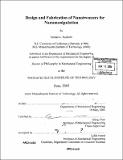| dc.contributor.advisor | Gang Chen. | en_US |
| dc.contributor.author | Hashemi, Fardad Ali, 1976- | en_US |
| dc.contributor.other | Massachusetts Institute of Technology. Dept. of Mechanical Engineering. | en_US |
| dc.date.accessioned | 2008-04-24T08:55:06Z | |
| dc.date.available | 2008-04-24T08:55:06Z | |
| dc.date.copyright | 2005 | en_US |
| dc.date.issued | 2005 | en_US |
| dc.identifier.uri | http://hdl.handle.net/1721.1/35053 | |
| dc.description | Thesis (Ph. D.)--Massachusetts Institute of Technology, Dept. of Mechanical Engineering, 2005. | en_US |
| dc.description | Includes bibliographical references (leaves 138-139). | en_US |
| dc.description.abstract | Experimentation and realization of new product concepts at the nanoscale present new challenges. Due to the diffraction limit of visible light it is not possible to see at this scale using optical microscopes. The Scanning Tunneling Microscope (STM) and the Atomic Force Microscope (AFM) are widely used tools for visualization at this scale and serve as the eyes into the nano-world. The ability to probe, manipulate, and construct at this scale is a continuing challenge that needs to be addressed. There are concurrent projects in both industry and academia to construct nanotweezers to serve as the hands and arms for nanomanipulation. Most such devices are not fabricated using completely batch processes and lack the consistency, feature definition, and ease of production required for general use. In this project, we propose a completely batch fabricated nanotweezer designed for compatibility with the AFM. We have developed a completely batch process for making overhanging, electrostatically actuated, compliant mechanism nanotweezers with nanoscale gripper motion resolution. The nanotweezer we tested requires lower actuation voltage and is more compliant than other similar grippers. It also has desired out of plane stiffness and resonance modes for operation with the AFM. We have also developed a batch process to fabricate self-aligned nanoscale tips with nanoscale spacing without the need for nanoscale lithography. The two processes are compatible and can be combined to batch fabricate consistent and practical nanotweezers for large scale use. | en_US |
| dc.description.statementofresponsibility | by Fardad A. Hashemi. | en_US |
| dc.format.extent | 139 leaves | en_US |
| dc.language.iso | eng | en_US |
| dc.publisher | Massachusetts Institute of Technology | en_US |
| dc.rights | M.I.T. theses are protected by
copyright. They may be viewed from this source for any purpose, but
reproduction or distribution in any format is prohibited without written
permission. See provided URL for inquiries about permission. | en_US |
| dc.rights.uri | http://dspace.mit.edu/handle/1721.1/7582 | en_US |
| dc.subject | Mechanical Engineering. | en_US |
| dc.title | Design and fabrication of nanotweezers for nanomanipulation | en_US |
| dc.type | Thesis | en_US |
| dc.description.degree | Ph.D. | en_US |
| dc.contributor.department | Massachusetts Institute of Technology. Department of Mechanical Engineering | en_US |
| dc.identifier.oclc | 70221737 | en_US |
